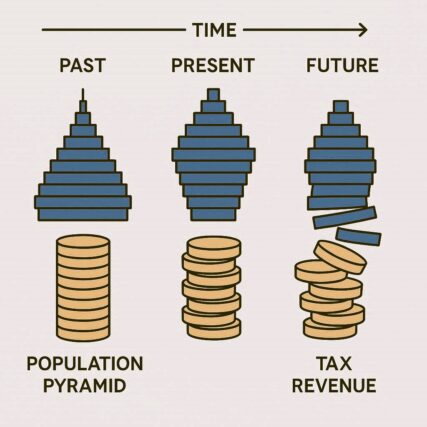少子高齢化の時代、税のあり方はどう変わるのか?
日本の人口構造は、かつてないスピードで変化しています。出生率の低下と高齢化の進行は、社会保障や地域経済だけでなく、税収の構造にも大きな影響を与えています。
人口動態の変化が税収にどのような移り変わりをもたらし、これからどのような未来を描くのでしょうか?
税収の構造はどう変わってきたか
前回のブログ「相続税のシェア」にも登場した以下のグラフが過去約30数年間の税収の移り変わりを表しています。
税収の過去
かつての日本では、人口増加と高度経済成長に支えられていました。1989年(平成元年)に消費税が導入されて間もない頃は、所得課税が税収の大半を占めていました。しかし、1990年代以降、バブル崩壊と共に人口の伸びが止まり、税収の質が変化し始めます。
減少する所得を補うかたちで間接税である消費税の税率上昇がはじまり、以下の黒い折れ線グラフの通り、税率3%→5%→8%→10%と、約30数年かけて段階的に上昇し推移していきました。
税収の現在地
2025年9月1日現在の総務省統計局による概算値では、日本の総人口は1億2,400万人を下回り、生産年齢人口(15〜64歳)は全体の約59%まで低下しています(人口推計 2025年(令和7年)9月報)。
生産年齢人口が減少すると、所得税や住民税など「働く世代」からの税収も比例して減少傾向になると考えられ、現状維持のまま何もイノベーションが起こらなければ経済規模の縮小は時間の問題と考えられています。
また、医療・介護などの社会保障費は増加の一途をたどっており、財政の持続可能性が問われています。

※出典:税収に関する資料 : 財務省
そして未来は?
明らかに「人口」に依存できなくなるため、所得水準の維持あるいは質の向上のため、生きがいをもって働くことのできる環境の整備、そして生命線とも読み取れる消費税とのバランス維持が、ますます重要な要素になるのでは、と感じます。それとともに、税の配分の在り方が希望を持てる未来へ導いていくと信じたいものです。
まとめ
人口動態の現在の立ち位置を受け止め、危機にどう向き合い生きていくかは私たち次第です。税収の移り変わりが歴史に刻む変化を理解し、未来の在り方を一人一人が考えることも持続可能な社会を築くために必要なことかもしれませんね。
How Will Tax Policy Evolve in an Era of Population Decline and Aging?
Japan’s demographic structure is undergoing an unprecedented transformation. Declining birth rates and a rapidly aging population are reshaping not only social security and regional economies, but also the very foundation of our tax system.
How are these demographic shifts influencing tax revenue—and what kind of future might they lead us toward?
How Has the Structure of Tax Revenue Changed?
The graph featured in our previous post, “The Share of Inheritance Tax,” illustrates how Japan’s tax composition has evolved over the past three decades.
Tax Revenue in the Past
Japan once thrived on population growth and rapid economic expansion. In 1989, the first year of the Heisei era, the newly introduced consumption tax played a minor role, while income-based taxation accounted for the majority of revenue. However, following the burst of the economic bubble in the 1990s, population growth stalled—and the nature of tax revenue began to shift.
To compensate for declining income levels, the government gradually raised the consumption tax rate, a form of indirect taxation. As shown in the black line graph, the rate increased step-by-step from 3% to 5%, then 8%, and finally 10% over the course of more than 30 years.
Where We Stand Today
As of September 1, 2025, Japan’s estimated total population has fallen below 124 million, with the working-age population (ages 15–64) now comprising just 59% of the total, according to the Statistics Bureau of the Ministry of Internal Affairs and Communications (人口推計 2025年(令和7年)9月報Population Estimates, September 2025).
As the working-age population declines, revenue from income and resident taxes—those primarily paid by the labor force—is also expected to decrease proportionally. Without innovation or structural reform, maintaining the status quo could lead to an inevitable contraction of the overall economy.
Meanwhile, social security expenditures such as healthcare and elder care continue to rise, raising serious concerns about the long-term sustainability of public finances.
What Lies Ahead?
As it becomes increasingly clear that we can no longer rely on population growth alone, maintaining—or even enhancing—income levels will require more than just economic measures. We must cultivate environments where people can work with purpose and fulfillment. At the same time, striking a sustainable balance with consumption tax—which now functions as a fiscal lifeline—will become ever more critical.
We also believe that how tax revenue is allocated can guide us toward a future we can truly look forward to.
Conclusion
How we respond to today’s demographic realities—and how we choose to live through this period of change—is ultimately up to us. By understanding the historical shifts in tax revenue and reflecting on what kind of future we want to shape, each of us can play a part in building a more sustainable society.


